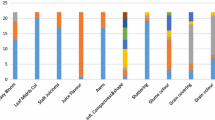Abstract
Saccharum spontaneum L., one of the wild species in Saccharum complex has reservoir of genes for various economically important traits including resistance to biotic and abiotic stresses. Its contribution in the development of modern sugarcane varieties through nobilization has resulted in the first sugar revolution in the country. In India, many explorations were conducted by Sugarcane Breeding Institute, Coimbatore and several valuable germplasm were collected and maintained for further utilization. The arid and semi arid zones of northwestern India are the unexplored regions of the country and collections from these zones would be valuable in terms of tolerance to abiotic stresses. An exploration was conducted in the six agro climatic zones of northwestern India in the state of Gujarat. A total of 32 collections were made and detailed information on passport data and various important descriptors were documented. These clones were planted and characterized for ten quantitative and 26 qualitative traits. The collections showed the existence of high variability for most of the traits. Clustering based on phenotypic data grouped whole collections into six clusters. Clones from high rainfall south Gujarat (Cluster II) and low rainfall western arid (Cluster III) and north Gujarat (Cluster IV) were grouped into separate clusters. This paper describes the potential uses of the S. spontaneum collected in northwestern India and further utilization in sugarcane improvement programmes.



Similar content being viewed by others
References
Aitken, K., and M. McNeil. 2010. Diversity analysis. In Genetics, genomics and breeding of sugarcane, ed. R.J. Henry, and C. Kole, 19. Enfield: Science Publishers.
Amalraj, V.A., and N. Balasundaram. 2006. Status of sugarcane genetic resources in India. PGR Newsletter 148: 26–31.
Arceneaux, G. 1967. Cultivated sugarcanes of the world and their botanical derivation. Proceedings of International Society of Sugar Cane Technologists 12: 844–854.
Besse, P., C.L. McIntyre, and B.N. Berding. 1997. Characterisation of Erianthus sect. Ripidium and Saccharum germplasm (Andropogoneae–Saccharinae) using RFLP markers. Euphytica 93: 283–292.
Berding, N., and B.T. Roach. 1987. Germplasm collection, maintenance, and use. In Sugarcane improvement through breeding, ed. D.J. Heinz, 143–210. Amsterdam: Elsevier.
Brown, J.S., Schnell, R.J, Tai, P.Y.P. and J.D. Miller. 2002. Phenotypic evaluation of Saccharum barberi, S. robustum, and S. sinense germplasm from the Miami, FL, USA world collection. Sugarcane International 3–16, Sept–Oct 2002.
Burner, D.M., and B.L. Legendre. 2000. Phenotypic variation of biomass yield components in F1 hybrids of elite sugarcane crossed with Saccharum officinarum and S. spontaneum. American Society of Sugar Cane Technologists 20: 81–87.
Chu, T.L., P.Y. Juang, and K.C. Shang. 1962. The wild cane (S. spontaneum) in Taiwan. Reporter Taiwan Experiment Station 28: 1–11.
D’Hont, A., D. Ison, K. Alix, C. Roux, and J.C. Glaszmann. 1998. Determination of basic chromosome numbers in the genus Saccharum by physical mapping of ribosomal RNA genes. Genome 41: 221–225.
Daniels, J., and C.A. Daniels. 1975. Geographical, historical and cultural aspects of the origin of the Indian and Chinese Sugarcanes S. barberi and S. sinense. Sugarcane Breeding Newsletter 36: 4–23.
Daniels, J., and B.T. Roach. 1987. Taxonomy and evolution. In Sugarcane improvement through breeding, ed. D.J. Heinz, 7–84. Amsterdam: Elsevier.
Harvey, M., and F.C. Botha. 1996. Use of PCR-based methodologies for the determination of DNA diversity between Saccharum varieties. Euphytica 89: 257–265.
Harvey, M., B.L. Huckett, and F.C. Botha. 1994. Use of polymerase chain reaction (PCR) and random amplification of polymorphic DNAs (RAPDs) for the determination of genetic distances between 21 sugarcane varieties. Proceedings of the South African Sugar Technologist Association 68: 36–40.
Kandasami, P.A., T.V. Sreenivasan, K. Palanichami, and T.C. Ramana Rao. 1983. Sugarcane germplasm: classification of clones. Sugar Cane 2: 1–3.
Lu, Y.H., A. D’Hont, D.I.T. Walker, P.S. Rao, P. Feldmann, and J.C. Glaszmann. 1994. Relationships among ancestral species of sugarcane revealed with RFLP using single-copy maize nuclear probes. Euphytica 78: 7–18.
Mary, S., N.V. Nair, P.K. Chaturvedi, and A. Selvi. 2006. Analysis of genetic diversity among Saccharum spontaneum L. from four geographical regions of India, using molecular markers. Genetic Resources and Crop Evolution 53(6): 1221–1231.
Naidu, K.M. and T.V. Sreenivasan. 1987. Conservation of sugarcane germplasm. In Corpersucar international sugarcane breeding workshop. Copersucar Technology Center, Piracicaba-SP, Brazil, pp 33–70.
Pan, Y.B., D.M. Burner, B.L. Legendre, M.P. Grisham, and W.H. White. 2004. An assessment of genetic diversity within a collection of Saccharum spontaneum L. with RAPD PCR. Genetic Resources and Crop Evolution 51: 895–903.
Rao, J.T. and U. Vijayalakshmi. 1963. World catalogue of sugarcane genetic stock. Sugarcane Breeding Institute (ICAR), Coimbatore, India, pp 1–77.
Roach, B.T. 1984. Conservation and use of the genetic resources of sugar cane. Sugar Cane 2: 7–11.
Skinner, J.C., D.M. Hogarth, and K.K. Wu. 1987. Selection methods, criteria, and indices. In Sugarcane Improvement through Breeding, ed. D.J. Heinz, 409–453. Amsterdam: Elsevier.
Sreenivasan, T.V., B.S. Ahloowalia, and D.J. Heinz. 1987. Cytogenetics. In Sugarcane improvement through breeding, ed. D.J. Heinz, 211–253. New York: Elsevier.
Sreenivasan, T.V., V.A. Amalraj, and A.W. Jebadhas. 2001. Sugarcane genetic resources: Saccharum spontaneum, vol. 2. Coimbatore: Sugarcane Breeding Institute.
Stevenson, G.C. 1965. Genetics and breeding of Sugar cane. London: Longmans.
Tai, P.Y.P., J.D. Miller, and B.L. Legendre. 1994. Preservation of Saccharum spontaneum germplasm through storage of true seed. Sugar Cane 6: 3–8.
Tai, P.Y.P., J.D. Miller, and B.L. Legendre. 1995. Evaluation of the world collection of Saccharum spontaneum L. Proceedings of International Society of Sugar Cane Technologists 21: 250–260.
Tew, T.L. 1987. New varieties. In Sugarcane improvement through breeding, ed. D.J. Heinz, 559–594. New York: Elsevier.
Tew, T.L. 2003. World sugarcane variety census––Year 2000. Sugar Cane International pp 12–18.
Walker, D.I.T. 1972. Utilization of noble and S. spontaneum germplasm in the West Indies. Proceedings of International Society of Sugar Cane Technologists 14: 224–232.
Ward, J.H. 1963. Hierarchical grouping to optimize an objective function. Journal of the American Statistical Association 58: 236–244.
Author information
Authors and Affiliations
Corresponding author
Rights and permissions
About this article
Cite this article
Govindaraj, P., Amalraj, V.A., Mohanraj, K. et al. Collection, Characterization and Phenotypic Diversity of Saccharum spontaneum L. from Arid and Semi Arid Zones of Northwestern India. Sugar Tech 16, 36–43 (2014). https://doi.org/10.1007/s12355-013-0255-4
Received:
Accepted:
Published:
Issue Date:
DOI: https://doi.org/10.1007/s12355-013-0255-4




